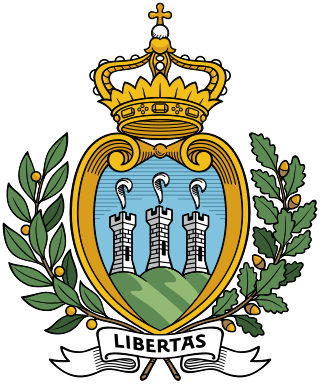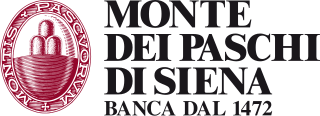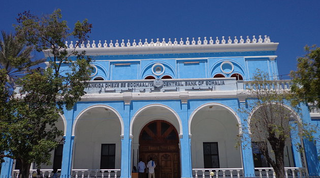
The Bank of Italy is the Italian member of the Eurosystem and has been the monetary authority for Italy from 1893 to 1998, issuing the Italian lira. Since 2014, it has also been Italy's national competent authority within European Banking Supervision. It is located in Palazzo Koch, via Nazionale, Rome.

San Marino, officially the Republic of San Marino and also known as the Most Serene Republic of San Marino, is a European microstate and enclave within Italy. Located on the northeastern side of the Apennine Mountains, it is the fifth-smallest country in the world, with a land area of just over 61 km2 and a population of 33,660 as of 2022.

Captains Regent are the two heads of state of the Republic of San Marino. They are elected every six months by the Grand and General Council, the country's legislative body. Normally the Regents are chosen from parties in coalition and serve a six-month term. The investiture of the Captains Regent takes place on 1 April and 1 October every year. This tradition dates back at least to 1243.

The Bank of Spain is the Spanish member of the Eurosystem and has been the monetary authority for Spain from 1874 to 1998, issuing the Spanish peseta. Since 2014, it has also been Spain's national competent authority within European Banking Supervision. It was originally established by Charles III in Madrid in 1782, as the Banco Nacional de San Carlos, and took its current name in 1856. Its activity is regulated by the Bank of Spain Autonomy Act. The bank doesn't translate its name to English but uses its Spanish name in all English communications.

The Central Bank of the Republic of Turkey (CBRT) is the central bank of Turkey. Its responsibilities include conducting monetary and exchange rate policy, managing international reserves of Turkey, as well as printing and issuing banknotes, and establishing, maintaining and regulating payment systems in the country.

The Sammarinese Communist Party was a Marxist political party in the small European republic of San Marino. It was founded in 1921 as a section of the Communist Party of Italy (PCI). The organization existed for its first two decades as an underground political organization.

Banca Monte dei Paschi di Siena S.p.A., known as BMPS or just MPS, is an Italian bank. Tracing its history to a mount of piety founded in 1472 and established in its present form in 1624, it is the world's oldest or second oldest bank, depending on the definition, and the fifth largest Italian commercial and retail bank.

The Swiss National Bank is the central bank of Switzerland, responsible for the nation's monetary policy and the sole issuer of Swiss franc banknotes. The primary goal of its mandate is to ensure price stability, while taking economic developments into consideration.

UniCredit S.p.A. is an international banking group headquartered in Milan. It was Italy's only systemically important bank and the world's 34th largest by assets. It was formed through the merger of Credito Italiano and Unicredito in 1998 but has a corporate identity stretching back to its first foundation in 1870 as Banca di Genova. UniCredit is listed on the Borsa Italiana and Frankfurt Stock Exchange and is a constituent stock of the Euro Stoxx 50 index of leading shares.

The Central Bank of Somalia (CBS) is the monetary authority of Somalia. Somalia has struggled to reestablish a functioning state since the collapse of an authoritarian regime in 1991. Somalia has been cited as a real-world example of an anarchist stateless society and a country with no formal legal system. The Transitional Federal Government, formed in 2004, was recognized as the central government of Somalia. Among other duties, it is in charge of ensuring financial stability, maintaining the internal and external value of the local currency, and promoting credit and exchange conditions that facilitate the balanced growth of the national economy. Within the scope of its powers, it also contributes to the financial and economic policies of the State.

Intesa Sanpaolo S.p.A. is an Italian international banking group. It is Italy's largest bank by total assets and the world's 27th largest. It was formed through the merger of Banca Intesa and Sanpaolo IMI in 2007, but has a corporate identity stretching back to its first foundation as Istituto Bancario San Paolo di Torino in 1583.

State auditors are fiscal officers lodged in the executive or legislative branches of U.S. state governments who serve as external auditors, program evaluators, financial controllers, bookkeepers, or inspectors general of public funds. The office of state auditor may be a creature of the state constitution or one created by statutory law.

The following outline is provided as an overview of and topical guide to San Marino:

The Central Bank of Kosovo is the central bank of Kosovo. It was founded in June 2008, the same year Kosovo declared its independence from Serbia, with the approval of Law No. 03/L-074 on the Central Bank of the Republic of Kosovo by the Kosovo Assembly. Before being established as the Central Bank of Kosovo, it operated as the Central Banking Authority of Kosovo. The official currency in Kosovo is the Euro, which was unilaterally adopted by the United Nations administration for Kosovo in 2002; however, Kosovo is not a member of the Eurozone. The headquarters of the CBK are located in the capital of Kosovo, Pristina.

This page list topics related to San Marino.
United Kingdom banking law refers to banking law in the United Kingdom, to control the activities of banks.
San Marino has recognized civil unions for both same-sex and opposite-sex couples since 5 December 2018. The law to permit civil unions became fully operational on 11 February 2019, following a number of further legal and administrative changes.

Ignazio Visco is an Italian economist and central banker and Governor of the Bank of Italy fromn 2011 to 2023.

The Bank of San Marino is an institution created on December 20, 1920, in Faetano, Republic of San Marino. It was don Eugenio Fabbri, then parish priest in Faetano, who, together with some parishioners, founded the first cooperative association in general partnership of that territory. Until 2001 it was called Rural Bank of Loans and Deposits in Faetano, then its name was changed to Bank of San Marino.
Fondazione Cassa di Risparmio di Verona, Vicenza, Belluno e Ancona, also known as Fondazione Cariverona is an Italian banking foundation based in Verona, Veneto region. The foundation was created in 1991.















